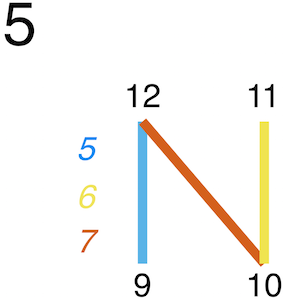bmotif is software for motif analyses of bipartite networks. It can count occurrences of motifs in bipartite networks, as well as the number of times each node or link appears in each unique node or link position within motifs (a node or link’s structural role). bmotif supports weighted as well as unweighted networks: the mean weight of motifs can be calculated, as well as the standard deviation of motifs mean weights; weighted versions of node and link position counts are also supported (see below). As well as R, core functionality is also available in MATLAB and Python. bmotif was originally developed to analyse bipartite species interaction networks in ecology but its methods are general and can be applied to any bipartite graph.
Note that the released version on CRAN currently only has support for counting motif occurrences and node positions. It does not have support for link positions or weighted networks, which are currently only available in the development version (these will be added to the CRAN version when development is finalised).
To install the released version from CRAN:
To install the development version from GitHub:
install.packages("devtools") # install the devtools package
devtools::install_github("SimmonsBI/bmotif", build_vignettes = TRUE) # install bmotifSome users have reported issues installing bmotif without the Rcpp package being installed. Therefore we recommend installing Rcpp before installing bmotif:
If installing on Windows, you might get an error saying something like ‘Rtools is required to build R packages, but no compatible version was found’. Even after you install the latest version of Rtools you may get ‘ERROR: compilation failed for package ’bmotif’. If you get these errors, try these steps:
c:\Rtools\bin;c:\Rtools\mingw_32\bin;Sys.getenv('PATH') in R to make sure the correct PATH variables appear.devtools::find_rtools() which should now return TRUEbmotif considers all 44 unique bipartite motifs up to six nodes. Within these motifs there are 148 unique node positions and 106 unique link positions. All motifs, node positions and link positions considered by bmotif are shown in the Figure below. This is the ‘dictionary’ used by bmotif: the canonical reference for all motif, node position and link position IDs used by the package and returned by the functions.

Large numbers above and to the left of each motif represent the ID of a motif. Small numbers at the end of links represent node position IDs within motifs. Small numbers to the left of each motif represent link position IDs within motifs: the colour of the link position number corresponds to the colour of the links in the motif. Colours are colourblind safe following the palette proposed by Wong et al (2011). Motif IDs and node position IDS can also be found in Simmons, B. I., Sweering, M. J. M., Schillinger, M., Dicks, L. V., Sutherland W. J., Di Clemente, R. bmotif: a package for motif analyses of bipartite networks. Methods in Ecology and Evolution, 10(5), 695-701.. Link position IDs are only in the Figure above. Node positions were defined following Baker et al (2015) Appendix 1 Figure A27.
Consider the example of motif 5:

We know this is motif 5 because the large number above and to the left of the motif gives the motif ID as 5. This motif contains four unique node positions, given by the numbers at the ends of each link: 9, 10, 11 and 12. This motif also contains three unique link positions given by the three coloured numbers to the left of the motif. The leftmost link between positions 9 and 12 is in link position 5, the rightmost link between positions 10 and 11 is in link position 6, and the middle diagonal link between positions 10 and 12 is in link position 7.
bmotif has three functions, with can all be used with binary or weighted networks:
mcount
node_positions:
link_positions:
Weighted methods for mcount, link_positions and the ‘mora’ method in node_positions were originally defined by Mora et al. (2018).
The code is released under the MIT license (see LICENSE file).
If you use the package in your work, please cite: Simmons, B. I., Sweering, M. J. M., Schillinger, M., Dicks, L. V., Sutherland W. J., Di Clemente, R. bmotif: a package for motif analyses of bipartite networks. Methods in Ecology and Evolution 10(5), 695-701.
If you use any of the weighted analyses originally defined by Mora et al. (2018) (weighted mcount, weighted link_positions and the ‘mora’ method in node_positions), please additionally cite: Mora, B.B., Cirtwill, A.R. and Stouffer, D.B., 2018. pymfinder: a tool for the motif analysis of binary and quantitative complex networks. bioRxiv, 364703.
Baker, N.J., Kaartinen, R., Roslin, T. and Stouffer, D.B., 2015. Species’ roles in food webs show fidelity across a highly variable oak forest. Ecography, 38(2), pp.130-139.
Mora, B.B., Cirtwill, A.R. and Stouffer, D.B., 2018. pymfinder: a tool for the motif analysis of binary and quantitative complex networks. bioRxiv, 364703.
Wong, B. Points of view: Color blindness. Nat. Methods 8, 441 (2011).